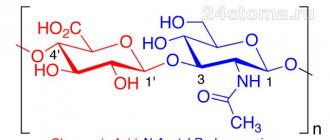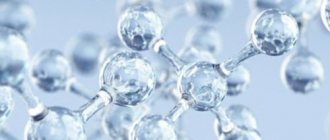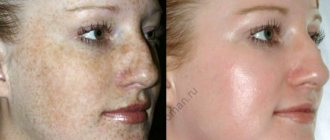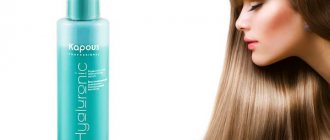December 14, 2021
- What is hyaluronic acid
- What is hyaluronic acid made from?
- Beneficial features
- Types of hyaluronic acid Low molecular weight
- High molecular weight
- Cleansing and toning
Hyaluronic acid is known as a miracle ingredient, a beauty elixir that can restore youth to the skin and is therefore very often used in cosmetics. We'll tell you what this substance is, what its benefits are and whether it can be harmful.
What is hyaluronic acid
Hyaluronic acid, or hyaluronate, is found in any body and is a “building material”. It is found in connective tissues and skin and is responsible for retaining moisture. One hyaluronate molecule is capable of holding a volume of water that is a thousand times greater than its own volume.
As you age, your body produces less and less of this substance. This is due to:
- natural cell aging;
- exposure to UV radiation;
- bad environment;
- unhealthy lifestyle and some other factors.
Due to a lack of hyaluronate, the epidermis begins to suffer from dryness, and as a result, visible signs of aging appear and develop. Fortunately, the lack of this substance can be replenished externally. Back in the 30s of the 20th century, they learned to isolate the component and later synthesize it.
How a lack of hyaluronic acid leads to skin aging -
Almost all of the skin's hyaluronic acid is located in its dermal layer (Fig. 2) - exactly where the collagen and elastin fibers responsible for skin elasticity are located. Loss of moisture (dehydration) from this layer of skin leads to the following effects:
- Slow collagen degeneration - a decrease in the amount of hyaluronic acid leads to a decrease in water content in the dermis, which leads to weak hydration of collagen and elastin fibers with water. Under these conditions, slow degeneration of collagen fibers occurs with a gradual decrease in its quantity. In addition, all other collagen loses the proper degree of plasticity (ability to shrink/decompress). And this affects the elasticity of the skin.
- Reduced skin thickness – dehydration of the dermal layer of the skin leads to a decrease in its thickness, accordingly, the skin becomes thinner and less elastic. Thin skin is more prone to the early appearance of wrinkles.
- Reduced activity of fibroblasts and keratinocytes - fibroblasts are responsible for the synthesis of collagen and elastin. When there is a lack of hyaluronic acid, their activity decreases, which affects their collagen production. The activity of keratinocytes, on which the thickness of the epidermal layer of the skin depends, also decreases. A decrease in the thickness of the epidermis leads to a decrease in the protective properties of the skin and to greater evaporation of water from its surface.
Hyaluronic acid for the face: reviews from cosmetologists... thus, the additional supply of hyaluronic acid (with a decrease in its content in the dermis) helps ensure that the dermis is saturated with moisture and the collagen remains sufficiently hydrated with water. Plus, the activity of fibroblasts and keratinocytes increases, stimulates angiogenesis, cell regeneration, and metabolic processes. All this keeps the skin well hydrated, elastic and, accordingly, prevents the development of wrinkles.
What is hyaluronic acid made from?
Hyaluronate can be obtained in two ways:
- isolated from animal raw materials;
- synthesize artificially.
Previously, the substance was isolated from fish, cattle cartilage, and rooster combs, but now a biotechnological method is common, in which lactic acid bacteria are used for fermentation. The substance is purified and dried to a powder state. It is in this form that it is able to penetrate deeply into the layers of the epidermis.
In addition to cosmetics, hyaluronate is widely used in orthopedics, ophthalmology (including for the manufacture of contact lenses) and eye surgery. The substance may also be included in food supplements.
Let us briefly summarize the results of the study:
The analysis was carried out in comparison with high molecular weight hyaluronic acid, molecular weight 800 kDA - an active cosmetic ingredient that has been used in cosmetology for a long time and is known for its unique moisturizing properties
.
The result showed that unlike 800kDa hyaluronic acid, which affects 40 genes, 50kDa hyaluronic acid significantly affects more than 120 genes, including key genes that are responsible for the formation of complex complexes of compounds. It turns out that the traditional component for the cosmetic market is high molecular weight hyaluronic acid with a molecular weight of more than 800 kDa. Unfortunately, this molecule size is too large
to penetrate the skin.
However, it is very effective in combating the loss of natural moisture in the skin and provides excellent instant hydration. At the same time, low molecular weight hyaluronic acid
with a molecular weight of 50 kDA
is a much more effective form at the gene-regulating level.
Comparative tests of 50, 300, 800 and 1500 kDA acids showed that hyaluronic acid with a molecular weight of more than 300 kDa
penetrates the skin very poorly
.
After just 5 hours of experimentation,
50Kda hyaluronic acid demonstrated a threefold advantage, proving the relationship between the size of the acid and its penetrating ability.
8-week comparative tests
were also conducted on female volunteers.
3 different hyaluronic acids with sizes of 50, 130 and 300 kDa were tested. Research has shown that 50kDa HA not only improves skin softness, but also has significant anti-wrinkle properties. While the most popular 800 kDa type of HA in cosmetics does not have such properties, but only provides a surface moisturizing effect. But less doesn't mean the better. It was also found that hyaluronic acid less than 20 kDA in size contributes to the occurrence of inflammatory processes in the skin.
Thus, low molecular weight hyaluronic acid with a molecular weight of 50 kDa has optimal properties for penetration into the skin, compared to high molecular weight hyaluronic acid, and affects the formation of intercellular complexes of compounds, the production of which decreases with age.
The study confirms that the superficial application of hyaluronic acid improves the condition of the skin, promotes its normal functioning, and also has a proven anti-aging effect.
We hope this information will help you make the right choice.
We would like to add on our own behalf .
Piel Cosmetics products use 50 kDa hyaluronic acid as the most effective type of this component .
It is important that low molecular weight hyaluronic acid, in certain products, is used in combination with high molecular weight. This combination allows you to achieve the maximum effect:
- improvement of skin condition, normalization of its functioning, as well as an anti-aging effect thanks to low molecular weight hyaluronic acid. - instant surface hydration and preventing the loss of natural moisture of the skin, thanks to the properties of high molecular weight.
Source:
SOFW Journal International Journal for Applied Science, English Edition December, 2008
Types of hyaluronic acid
There are two types of hyaluronate used in cosmetics: low molecular weight and high molecular weight. Let's tell you a little more about each of the varieties.
Low molecular weight
This substance is able to quickly penetrate into the deep layers of the epidermis, due to which it is used in cosmetics. It is included in creams, serums, anti-acne products and other cosmetic products.
High molecular weight
This type of hyaluronate is used in cosmetology, as it slowly breaks down in tissues. This quality allows you to achieve a long-term effect after the procedure. The substance can also be used in cosmetics, but it does not penetrate deep and does not form intercellular connections. When applied to the skin, high molecular weight hyaluronic acid serves to provide superficial hydration.
Hyaluronic acid: questions and answers
You probably know that the Anti-Aging Lecture Project Bureau regularly conducts popular science lectures
, dedicated to the issues of “Skin Biology”.
If you haven't seen it yet, be sure to check it out
. In the meantime, expanding the scope of this section, we turned to the candidate of medical sciences, Dr. Alexey Prokopov, to find out how hyaluronic acid affects the youth of the skin and by what means the body can enhance its synthesis. What is GC?
What is hyaluronic acid?
In cosmetology, a somewhat simplified idea of hyaluronic acid is common.
To the average person, it appears as a kind of “water magnet” that forms the volume and viscoelastic properties of the dermal matrix. Hyaluronic acid (HA) provides skin turgor - a key element in maintaining youth. However, hyaluronic acid is much more complex. This is the most important element in controlling homeostasis and biomechanical properties of the intercellular space. We can confidently say this: without hyaluronic acid, humans as a species unit would not exist at all. In the distant past, it was its molecules that “lined the bridge” with the help of which life moved from the depths of the sea to land. But modern humans have very little hyaluronic acid: the body of an adult weighing 70 kg contains no more than 15 g of HA!
What is the value of HA for the body?
Hyaluronic acid is present in the cytoplasm and nucleus of cells, which emphasizes its direct involvement in intracellular processes.
This is a universal signaling molecule that affects all cells without exception. HA is a linear polymer that organizes the structure of the intercellular space. Without such an organization, multiple macromolecular complexes would not have formed in the human body. Hyaluronic acid forms a bacterial filter, and, through interactions with toll-like receptors (TLRs), supports. Hyaluronic acid forms macromolecules with other matrix components, influences the formation of complex fiber proteins and proteoglycans, thereby predetermining the continuous course of complex processes of modeling and remodeling of the intercellular matrix.
How is hyaluronic acid produced?
Depending on the length of the molecule, hyaluronic acid can have different effects on cell activity. At the same time, enzymes for the synthesis of HA are always present in the cell, dramatically reducing the time of transition to synthesis. Typically, the cell waits for a response within 4-5 hours: the signal reaches the DNA, the information is “rewritten” onto the messenger RNA, and protein synthesis begins from it. The enzyme for the synthesis of HA is located on the inside of the cell - having received a signal, it combines more and more monomers into a chain, which, like a wire, can connect one, two or thousands of cells. This is how connections are formed to build the intercellular matrix, build proteins, etc.
Is the cutaneous use of HA in cosmetology justified?
Considering that the epidermis atrophies with age, the use of low molecular weight hyaluronic acid is justified.
It is important to understand its stimulating effect here: HA neutralizes the atrophy of the epidermal barrier, helping to restore thickness. With the dermis everything is more complicated. In this case, cutaneous application of HA has minimal effect and is justified only as a factor in the formation of a hydrophilic film. With a mass above 5 kDa, hyaluronic acid molecules do not penetrate the surface layers of the skin in principle. In this sense, much more interesting are substances that do not have a chemical association with HA, but affect the cell. They help the body synthesize its own hyaluronic acid. The full scope of the biological meaning of HA cannot be realized when applying cosmetics to the surface of the skin - substances that stimulate the production of HA are much more effective.
How to stimulate the production of your own HA?
In fact, there are many effective cosmetic actives that stimulate the synthesis of hyaluronic acid. As a rule, these are amino acid complexes, the so-called promoters of hyaluronic acid synthesis. One of these is the liposomed U-Active HAP
. It includes substances with pronounced syncretism of action: magnesium ascorbyl phosphate, L-hydroxyproline and rutin disulfate di-sodium salt. With such a complex it is not necessary to reach fibroblasts - having reached keratinocytes, it increases the synthesis of hyaluronic acid in both the epidermis and dermis.
Why is hyaluronic acid indicated at any age?
Of the 15 g of hyaluronic acid in the human body, 11 g are found in the skin.
This is not enough, and she lives for three days. The skin continuously goes through cycles of destruction/creation of hyaluronic acid. Because of this, its quantity inevitably fades with age. By the age of 45, the amount of HA in the skin is reduced by 10 times, and by the age of 60 - by 20! We are quickly losing a key regulator of intercellular space and the flow of information molecules, and this is also why the skin ages. In this regard, the use of hyaluronic acid solutions is an excellent replacement therapy, the results of which are reflected on the skin. Injections based on HA are indicated from the age of 18 - the earlier the support of internal reserves of hyaluronic acid begins, the more reliably its destruction slows down.
How does hyaluronic acid work on the skin?
When the skin lacks moisture, it doesn't just feel dry. Over time, the skin becomes less firm and elastic, loses its radiance, and as a result, wrinkles may appear.
The use of low molecular weight hyaluronic acid replenishes the need for hydration of the epidermis, filling the intercellular space, which, in turn, has the following effects:
- the lipid layer is restored;
- elasticity and firmness of the skin returns, visible signs of age-related changes decrease or disappear;
- the skin becomes softer and more pleasant to the touch, the relief is evened out;
- complexion improves.
Low molecular weight, high molecular weight... What is it?
Everyone is used to affectionately calling it “hyaluronic acid,” but in fact, hyaluronic acid comes in different forms (“black, white, red...”







